DFI LANParty UT ICFX3200-T2R: ATI's, err, AMD's RD600 finally arrives
by Gary Key on December 16, 2006 7:00 PM EST- Posted in
- Motherboards
Standard Gaming Performance
As usual, gaming performance was tested with a variety of current games. We ran benchmarks with our standard 1280x1024 resolution without antialiasing enabled (and generally without anisotropic filtering, though that varies by game). Given the number of users that run 19 inch LCDs these days, 1280x1024 represents one of the most commonly used resolutions. We could certainly increase the amount of eye candy being displayed in most of the games, but as this is a motherboard benchmark we aren't particularly interested in maxing out the graphics cards for all tests.
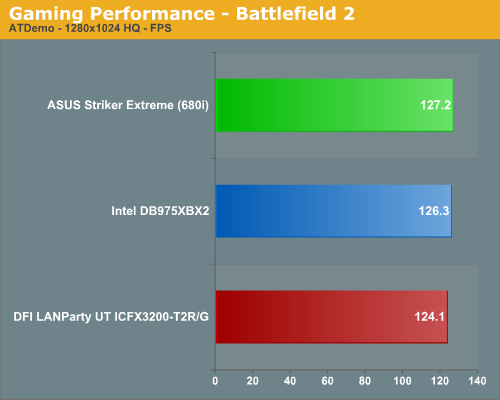
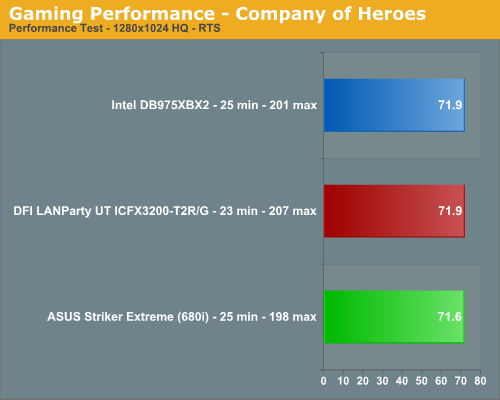
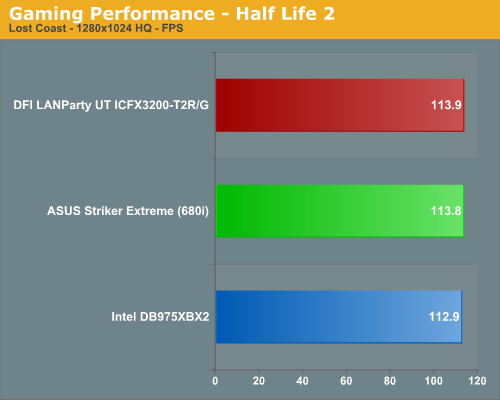
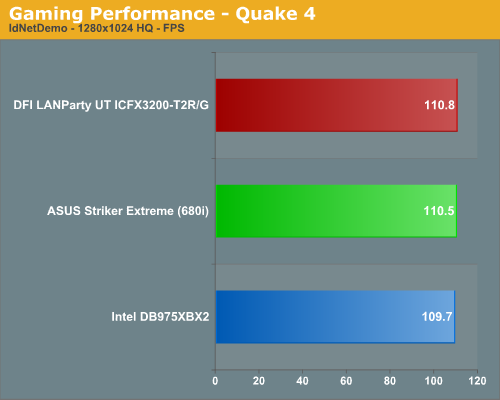
As we commented previously, gaming benchmarks seemed to favor the RD600 although our Battlefield 2 scores are puzzling considering the almost three percent drop in performance at these settings. Battlefield 2 at this time is fairly sensitive to CPU speed and memory timing improvements which did occur as we changed either our CPU speed or optimized our memory settings, but the board never caught the 975X or 680i at the same settings. However, very few people would ever notice a difference between the various motherboards while gaming although Quake 4 seemed more fluid on the DFI board during online game play across our LAN. We will be testing the DFI board with the GeForce 8800GTX to see how well it performs but at this time most games seem to favor the RD600 while Battlefield 2 does not, at least in single card testing.
High-Resolution Gaming Performance
For high-quality gaming performance, we also tested at 1600x1200 with 4xAA/8xAF. As just about anyone familiar with current games can tell you, benchmarking with a single high-end graphics card at those stressful settings will make almost any recent game GPU limited. In fact, several of the most recently released games such as Oblivion can be GPU limited at this setting even with CrossFire or SLI setups. Our test results are limited to two games for now, but we will provide expanded coverage in our next article, including Intel P965 and 1920x1200 results.
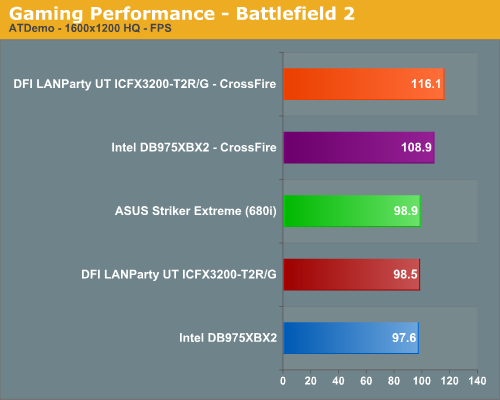
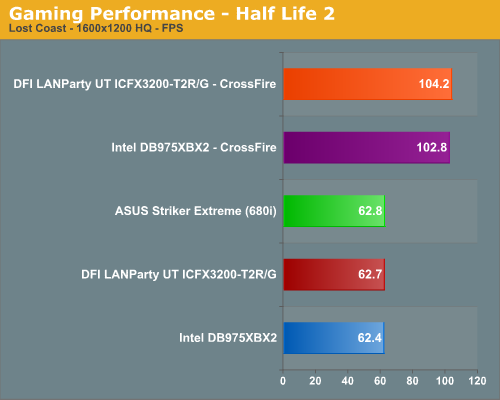
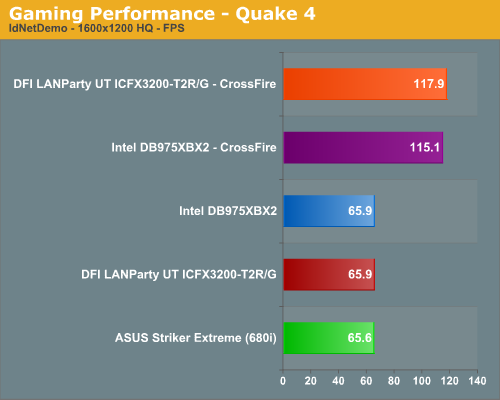
If you're serious about gaming at higher resolutions with all the eye candy enabled, you will most certainly want to run a multi-GPU configuration. Looking specifically at the DFI board, its relative positioning has improved greatly when playing Battlefield 2 under CrossFire along with improvements in Half Life 2: Lost Coast. It appears the optimizations that ATI built into their chipsets for CrossFire performance are indeed noticeable at the higher resolutions. Our 1280x1024 CrossFire testing yielded very few differences but the performance gap between the 975X and RD600 widened as we increased our resolution and AA/AF settings. We also noticed this same behavior in other games that we tested including Company of Heroes and F.E.A.R.
The only issue with X1950 CrossFire now is that NVIDIA's 8800 GTS/GTX cards can provide substantially higher performance, particularly in SLI configurations. As usual, SLI is not officially supported by NVIDIA on non-NVIDIA chipsets, and likewise you can't run CrossFire on NVIDIA chipsets. That means that 8800 GTX SLI and a 680i board would currently be a faster gaming solution, but AMD will counter with R600 early next year. Whether or not they can reclaim the performance crown remains to be seen, so if you're not in any hurry to spend a lot of money on upgrading it might be best to wait and see what happens.
As usual, gaming performance was tested with a variety of current games. We ran benchmarks with our standard 1280x1024 resolution without antialiasing enabled (and generally without anisotropic filtering, though that varies by game). Given the number of users that run 19 inch LCDs these days, 1280x1024 represents one of the most commonly used resolutions. We could certainly increase the amount of eye candy being displayed in most of the games, but as this is a motherboard benchmark we aren't particularly interested in maxing out the graphics cards for all tests.




As we commented previously, gaming benchmarks seemed to favor the RD600 although our Battlefield 2 scores are puzzling considering the almost three percent drop in performance at these settings. Battlefield 2 at this time is fairly sensitive to CPU speed and memory timing improvements which did occur as we changed either our CPU speed or optimized our memory settings, but the board never caught the 975X or 680i at the same settings. However, very few people would ever notice a difference between the various motherboards while gaming although Quake 4 seemed more fluid on the DFI board during online game play across our LAN. We will be testing the DFI board with the GeForce 8800GTX to see how well it performs but at this time most games seem to favor the RD600 while Battlefield 2 does not, at least in single card testing.
High-Resolution Gaming Performance
For high-quality gaming performance, we also tested at 1600x1200 with 4xAA/8xAF. As just about anyone familiar with current games can tell you, benchmarking with a single high-end graphics card at those stressful settings will make almost any recent game GPU limited. In fact, several of the most recently released games such as Oblivion can be GPU limited at this setting even with CrossFire or SLI setups. Our test results are limited to two games for now, but we will provide expanded coverage in our next article, including Intel P965 and 1920x1200 results.



If you're serious about gaming at higher resolutions with all the eye candy enabled, you will most certainly want to run a multi-GPU configuration. Looking specifically at the DFI board, its relative positioning has improved greatly when playing Battlefield 2 under CrossFire along with improvements in Half Life 2: Lost Coast. It appears the optimizations that ATI built into their chipsets for CrossFire performance are indeed noticeable at the higher resolutions. Our 1280x1024 CrossFire testing yielded very few differences but the performance gap between the 975X and RD600 widened as we increased our resolution and AA/AF settings. We also noticed this same behavior in other games that we tested including Company of Heroes and F.E.A.R.
The only issue with X1950 CrossFire now is that NVIDIA's 8800 GTS/GTX cards can provide substantially higher performance, particularly in SLI configurations. As usual, SLI is not officially supported by NVIDIA on non-NVIDIA chipsets, and likewise you can't run CrossFire on NVIDIA chipsets. That means that 8800 GTX SLI and a 680i board would currently be a faster gaming solution, but AMD will counter with R600 early next year. Whether or not they can reclaim the performance crown remains to be seen, so if you're not in any hurry to spend a lot of money on upgrading it might be best to wait and see what happens.










42 Comments
View All Comments
Goty - Monday, December 18, 2006 - link
Well, as long as we're both doing it, then I guess we're even, eh?cmdrdredd - Saturday, December 16, 2006 - link
Who says 511 is max? Also who said it wasn't a limitation of the CPU or other components not being able to do that type of FSB?cmdrdredd - Saturday, December 16, 2006 - link
this board is not retail yet...511 is max for this beta/pre-release perhaps...but I bet the final will allow much higher. Plus, you see p965 boards allow you to select 550fsb and can't do it so it seems dumb to base a buying decision on what the bios allows you to choose but won't boot.Gary Key - Sunday, December 17, 2006 - link
The clockgen limits the FSB to 511 and memory to 658. The board is maxed out at these settings. As we stated in the article, the AMD System Manager lets you soft overclock but we could never get above 518FSB without locking the system up. DFI did hit 535+ in their labs with the soft clock routine but that was on a early BIOS release.RichUK - Saturday, December 16, 2006 - link
If the chipset requires high voltage then fair enough. But at least allow us to upgrade the heatsink on the chipset. Due to the design, I don’t quite see any other aftermarket heatsink that will fit its profile. I would have wished they used a design similar to the way Asus fix their heatsink assembly to the board.Or they could have just used an active cooling solution!
With all that put aside, I’ll still be purchasing this board as soon as I can!
Hopefully DFI won’t take long in releasing a BIOS that allows upwards of 500+ FSB from the BIOS. I want to get the max performance from my E6300!
I also don’t understand why they’re having so many issues with the BIOS coding :S
Griswold - Sunday, December 17, 2006 - link
Active cooling? Been to the official DFI forums lately? People dont want active chipset cooling if it can be avoided.RichUK - Sunday, December 17, 2006 - link
Neither do I.
However, if you’re required to further cool the chipset when under high voltage to obtain a higher FSB. Then maybe a better solution could have been implemented in the first place.
I thought I made that quite clear.
Lord Evermore - Sunday, December 17, 2006 - link
Why increase cost for everyone, and add more complexity and provide an opportunity for a higher failure rate, to add a feature that many people might not want or need, and which likely will be a detraction from the quality of the board to many people? People don't like fans on chipsets, period. There was a phase of those for a few years being used on every board, even if the chipset didn't particularly need it, and all that happened is people complained about fans failing, whiny noisy fans, dust collection, etc.Goty - Sunday, December 17, 2006 - link
I think a good solution to this would be to include an <i>optional</i> fan for cooling the NB.Lord Evermore - Monday, December 18, 2006 - link
That'd make the price even higher, since they'd be including a heatsink designed to work well on its own, as well as either a fan alone, or a heatsink fan assembly if the standard heatsink isn't designed for airflow with attached, or with no way to attach it.The solution is for people to screw a fan on the chipset if they want extra cooling beyond what is actually quite a high overclock with the standard heatsink.
However DFI could still have used a more standard and easily replaced retention mechanism. Of course there's always still thermal tape, epoxy or zip ties.